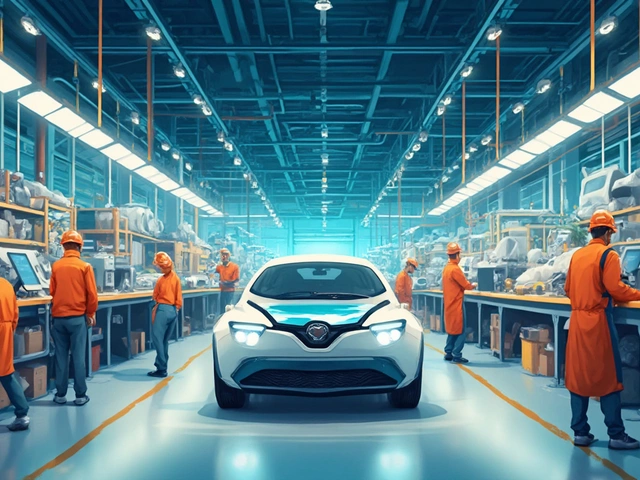Sitting in any bustling electronics store in Mumbai or browsing e-commerce for gadgets in Bengaluru, you’re probably looking at a device powered by semiconductors that have traveled halfway across the world. Hard to imagine, but almost every phone, laptop, and even air-conditioner relies on microchips made outside India. This dependency isn’t just about technology—it’s also about money, geopolitics, and a scramble for supply in a world that’s hungry for tech. If you’re curious who India’s biggest semiconductor suppliers are, and why it matters, then you’re in the right place.
Why India Imports So Many Semiconductors
India’s electronics manufacturing has exploded, especially since 2018, but there’s a catch—almost all the brains behind these gadgets (those tiny, mighty chips) are imported. Even with all the talk about ‘Make in India’, the actual homegrown chip manufacturing scene is still pretty much in its infancy. Why is that? Fabricating semiconductors isn’t easy. It needs mind-blowing precision, billion-dollar cleanrooms, and know-how that takes decades to perfect. Right now, India’s factories can handle assembly but not the ultra-complex job of making top-tier chips.
The exact numbers tell a wild story. According to India’s Department of Commerce data for the financial year 2023-24, the country imported over $25 billion worth of semiconductor devices, diodes, and transistors. That figure has been climbing nearly every year as Indians buy more smartphones and companies automate with smart machines. From 2001 to now, the rise is almost vertical on the chart. Another jaw-dropping bit? About 95% of India’s semiconductor demand is met by imports. So, every time you use Google Maps or play a mobile game, you’re tapping into something that took a long detour through international supply chains.
The world’s global chip shortage in 2020-21 really shook things up. With factories closing in places like Taiwan and Malaysia due to the pandemic, car companies in India had to slow down production. Even now, automakers and smartphone brands are wary, knowing supply isn’t guaranteed. This shakes up prices, makes planning nearly impossible, and drives home how heavily India leans on overseas suppliers.
Key Countries Supplying Semiconductors to India
Not all chips are made equal, and not all are made by the same nations. The big daddy of semiconductor supply to India is Taiwan. TSMC, Taiwan’s crown jewel, is the world’s largest and most advanced chipmaker. India imports everything from basic microcontrollers to high-end processors from Taiwan, which alone makes up more than 40% of the country’s semiconductor imports. Many Indian smartphone factories rely on Taiwanese shipments to keep their assembly lines humming.
Next in line is China, though this might surprise some. Despite rising tensions between the two countries, China remains a major exporter of basic semiconductors, sensors, and other electronic components to India. As per the Ministry of Commerce, India imported over $6 billion worth of semiconductor-related items from China in 2023-24. The reason is simple—Chinese firms produce chips at serious scale and competitive prices, making them an obvious choice for Indian manufacturers looking to push out affordable gadgets.
Singapore packs a punch for its size. Thanks to its status as a global electronics trading hub, Singapore is India’s third-largest source of semiconductors. Sometimes, manufacturers reroute chips from bigger plants in East Asia through Singapore’s free ports and then onto India. In fact, more than $2 billion worth of such electronics flow from Singapore to India every year.
The United States isn’t left out. Companies like Intel, Qualcomm, and Texas Instruments ship critical chips for everything from laptops to networking gear, and a good chunk of them make their way to India. According to trade statistics, about $1.5 billion worth of semiconductors and related devices arrived from the US in 2023-24.
Japan and South Korea deserve their own shout-outs. Samsung and SK Hynix (both from South Korea) are global behemoths in memory chips, and India is a juicy market for them. Similarly, Japanese giants like Renesas and Toshiba supply chips that go inside cars, appliances, and industrial machines across India—worth hundreds of millions of dollars in imports every year.
Worth noting: Chips don’t always come straight from these countries. Often, they’re designed in one country (like the US), manufactured in another (Taiwan or South Korea), and then traded via hubs (Singapore or Hong Kong). This global relay means the import data can get a little blurry, but the supply chain always leads back to these main players.
The Impact of Semiconductor Imports on India’s Industry
How do all these shipments actually shape the Indian tech scene? It’s huge. For one, the rise in semiconductor imports has let India carve out a solid spot in the global electronics assembly map. Indian factories churn out smartphones, ACs, TVs, and laptops not just for domestic use but for export, too. In 2024, India was the world’s second-largest smartphone manufacturer by volume—right after China. That’s mostly assembly, but it means jobs, new skills, and a lot of value added to the country’s economy.
Imports do have their downsides, though. When foreign suppliers catch cold, Indian factories sneeze. That’s exactly what happened during the chip shortage—automakers like Maruti and Tata saw months of production delays. Laptop stocks thinned out. Even basic electronics like washing machines and TVs faced delays. This kind of chokehold makes everyone nervous, from CEOs to regular buyers.
The government is definitely paying attention. There’s been a big push to set up homegrown chip fabs (factories) under programs like India Semiconductor Mission. Recently, the government announced tens of billions of dollars in incentives to attract leading global chipmakers to build plants on Indian soil. In 2024, companies like Micron (from the US) started building a facility in Gujarat, bringing hopes that at least some of the value chain will move here. But it’s going to take years, possibly a decade or more, before India can be self-reliant for advanced chips.
Some interesting facts: even chip design is seeing an India story. Around 20% of the world’s chip designers are Indian, working for firms in Silicon Valley and beyond. While the chips themselves are made overseas, Indian brains are already a crucial part of the global tech equation. Once local fabrication catches up, India could well be on its way to real chip independence.
Tips for Navigating India’s Semiconductor Import Scene
For businesses that rely on electronics—whether you’re a local gadget brand or a software company needing servers—watching the chip supply scene is critical. Here are some concrete tips for navigating this import-heavy system:
- Stay ahead of trends. When there are whispers about global shortages, buy ahead or lock in orders. Waiting for prices to drop often backfires as supply dries up.
- Build solid relationships with multiple suppliers, not just one. Sometimes a partner in Singapore can get you chips when stocks are low in China or Taiwan.
- Don’t ignore customs processes. Shipments can get delayed for weeks due to paperwork. Hire a good customs agent or team who knows how to handle semiconductor classification codes.
- Explore alternatives. For less mission-critical products, see if you can use chips from less affected regions, or even older models that might be in stock at lower prices.
- Watch government policies. India sometimes tweaks import duties to boost domestic manufacturing or in response to global trade tensions. These changes can add costs overnight; being in the loop is key.
- If you’re planning for the long-term, explore opportunities to collaborate with Indian startups venturing into chip design and fabrication. A small investment now could mean better supply security tomorrow.
Think about keeping some buffer inventory, especially for products in high demand. The best-run Indian electronics brands have weathered global chip storms just by stocking up a few extra weeks’ worth of inventory.
If you’re into investing, watching the semiconductor supply chain is a great way to spot companies that will benefit from India’s next moves in technology. Firms with strong import relationships or those dabbling in local chip production could see outsized gains.
Semiconductors might be buzzy, but the backstory—where they come from and how they land in your tech—is a maze of shipping containers, trade deals, and some serious engineering. India’s import game isn’t about to end soon, but change is brewing. With the right strategy, anyone—from CEOs to gadget enthusiasts—can stay ahead of the curve.





